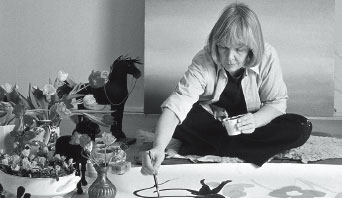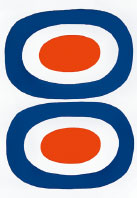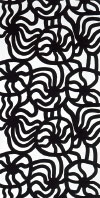マイヤ・イソラ Maija Isola (1927〜2001)

Marimekko Official Website

マイヤ・イソラ, 1963, DM

マイヤ・イソラ, 1961, DM
マイヤ・イソラは、1949年にプリンテックス社のテキスタイルデザイナーとなりました。1946〜1949年の間、工芸学校のテキスタイル学部で学んでいたマイヤは、最終学年時にプリント・ファブリック・コンクールに参加しました。そこでアルミ・ラティアがマイヤを見いだし、以来マイヤは38年間マリメッコの第一線で活躍し続けました。彼女が手がけたものは500以上にもなります。1980年代には、娘のクリスティーナとともにテキスタイルデザインの活動を行い、生地の端には2人の名前がプリントされました。
マイヤはテキスタイルデザイナーとしての仕事に加え、油絵やテンペラ画の画家としても活躍し、絵画で扱われたモチーフをファブリックに用いることもしばしばありました。自由を愛した彼女は頻繁に旅に出かけ、その経験はテキスタイルと絵画の両方に影響を与えました。彼女は1987年にマリメッコの仕事を引退し、亡くなるまで絵画を描き続けました。
アルミはプリントされた花は自然界の花にかなわないという持論から、花柄を禁止していました。しかし、マイヤは花を大きく扱った大胆なデザインをし、自分の仕事に制限を与えられたくないと主張しました。そこで誕生したのがウニッコ(Unikko、ケシの花、1964)です。ウニッコはテキスタイル界において非常に評価され、大きな成功を収めました。1970年代の中頃、大きなプリントが人気でなくなった時代に一線から姿を消したものの、1990年の終わり頃にファッションのプリントに使われ、再び人気の図案となりました。現在でもウニッコはマリメッコで最も人気が高い図案といえるでしょう。
参考文献
『マリメッコのすべて』 編著:マリアンネ・アーヴ, 訳:和田侑子, DU BOOKS, ディスクユニオン, 2013, p.295
『マリメッコ パターンとデザイナーたち』 執筆:マリア・ハルカパー /サミ・スッコ/アンヌッカ・アルヤヴィルタ/ミンナ・ケメル-クトゥヴォネン, 訳:島塚絵里, パイ インターナショナル, 2013, p.68-71
マリメッコ公式サイト
http://www.marimekko.jp/the-brand/designers/maija-isola
Maija Isola (1927〜2001)

Marimekko Official Website

Maija Isola, 1963, DM

Maija Isola, 1961, DM
In 1949 Maija Isola became the first full time designer hired by Printex company that spawned Marimekko two years later. She had studied in the Textile Department of Institute of Industrial Arts from 1946 to 1949. In her final year at school, she participated in the printed fabric design competition through which Armi Ratia discovered her talent. Since then, she had been active in Marimekko for 38 years producing more than 500 designs.
Maija was also an active painter in oils and tempera. She often used motifs of her paintings in fabric designs. She loved freedom and made frequent trips, experience of which gave profound influence in her designs and paintings. After leaving Marimekko, Maija returned to painting and pursued till her death.
Armi prohibited motifs of flowers since she believed that printed flowers were no better than flowers in the nature. Maija, on the other hand, made bold designs of big flowers, asserting that she should be free from any restriction in her work. Thus Unikko (poppy flower, 1964) was born. Unikko was highly evaluated in the textile industry with a great success. It disappeared from the market in the 1970’s when a big printed patterns were not in fashion, returning to the fabrics at the end of 1990. The motif regained popularity and it is one of the most popular designs of Marimekko even today.
References
“Marimekko: Fabrics, Fashion, Architecture” Editor Marianne Aav, Yale University Press, 2012, p.295
“MARIMEKKO kuvioissa” & “In Patterns MARIMEKKO” Editors Maria Härkäpää, Sami Sykkö, Annukka Arjavirta, Minna Kemell-Kutvonen
First published simultaneously in Finnish and in English by Werner Söderström Ltd in 2012.
Marimekko official websites
https://www.marimekko.com/com_en/the-brand/design/designers/maija-isola